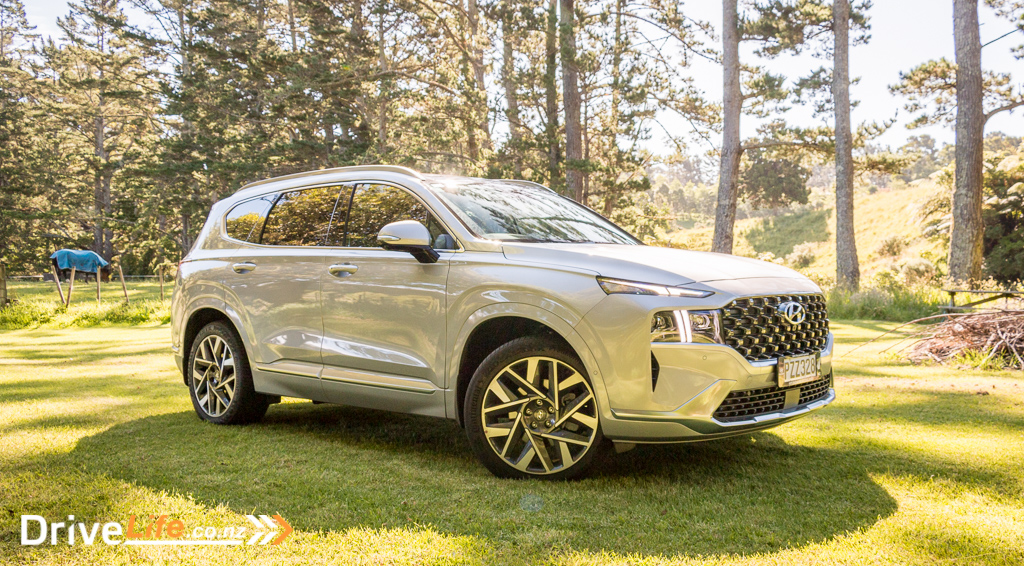Over Christmas 2023 my family came over to Taranaki for their first-ever trip outside Europe. I wanted to show them some of the North Island’s tourist destinations in style and Hyundai very kindly offered us a vehicle that seemed to fit that bill – the top-spec diesel-powered Santa-Fe Calligraphy.
We last tested this generation of Santa Fe back in 2021, with Fred testing the Limited spec and liking it very much, declaring it practically perfect. This late edition, likely the last ever purely diesel Santa Fe, is one of the last available before the new model comes out.
Does the impressively high spec justify the price tag for the Calligraphy edition? We drove it over 2,000km with five people and luggage on board, to give it a comprehensive test.
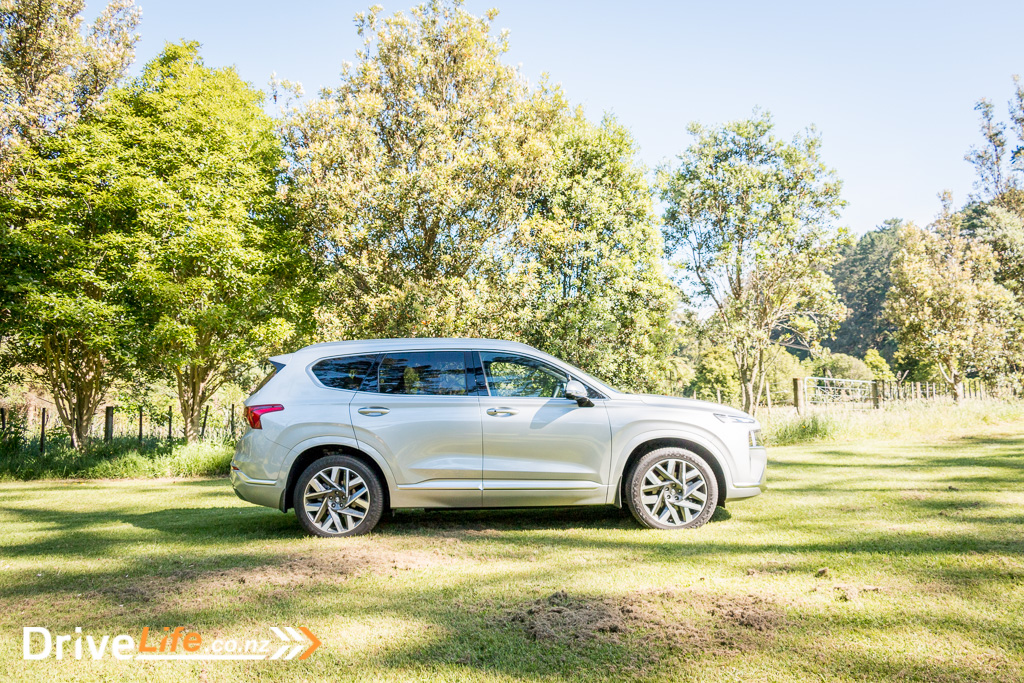
What We Like and Dislike About The 2023 Hyundai Santa Fe Calligraphy
| What we like | What we don’t like |
| Smooth and refined engine Great stereo Interior finish Ride and comfort 360 camera system | Third row entry/exit design |
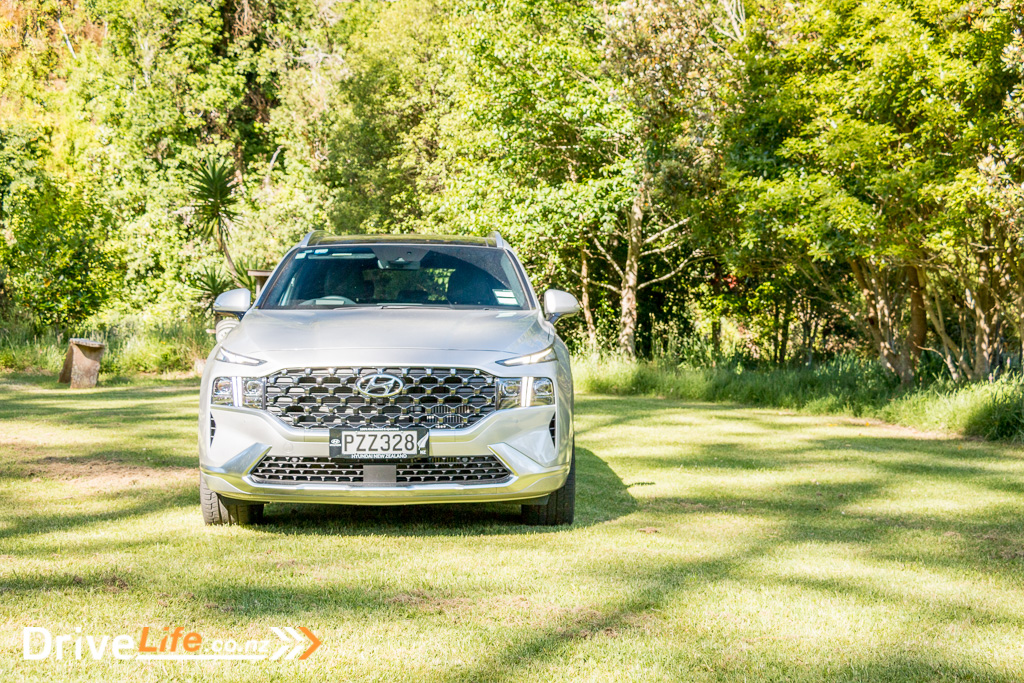
What’s In The 2023 Hyundai Santa Fe Range?
As this is an end-of life model for Hyundai the specs available are limited, and they have significant discounts on list price. Rather than me cover it all here and it go out of date, it’s best to check out their website for current pricing and availability.
The Calligraphy spec has a 2.2-litre 4-cylinder turbo-diesel motor producing 148kW of power and 440Nm of torque, driving all four wheels via an 8-Speed Dual Clutch Transmission. It retails at $94,990 but is currently discounted to $82,990.
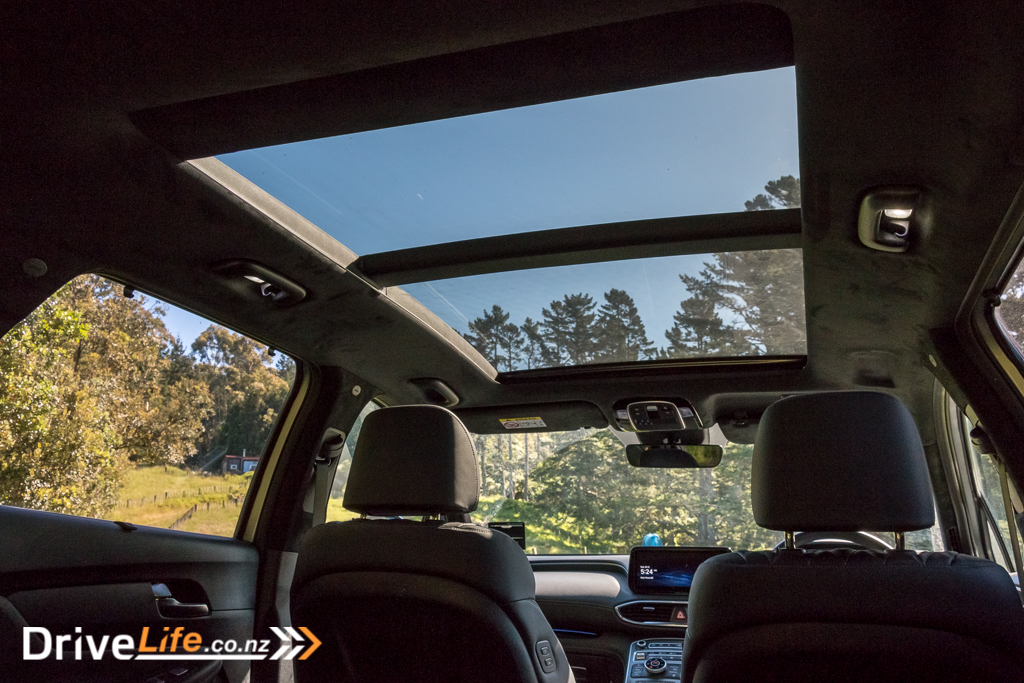
2023 Hyundai Santa Fe Standard Equipment Highlights
- Downhill Brake Control (DBC)
- Hill-start Assist Control (HAC)
- Electronic Shift By Wire gear selector (SBW)
- 20″ Calligraphy Alloys
- Full size alloy spare wheel & tyre
- Tyre Pressure Monitoring System (TPMS)
- ABS braking with Electronic Brake-force Distribution (EBD)
- Brake Assist System (BAS)
- Electronic Stability Control (ESC)
- Traction Control System (TCS)
- Vehicle Stability Management (VSM)
- Forward Collision-Avoidance with Junction Assist (FCA-JX)
- Reversing Collision Avoidance assist (RCA)
- Blind-spot Collision Avoidance assist (BCA)
- Blind-spot View Monitor system (BVM)
- Rear Cross-traffic Collision Avoidance assist (RCCA)
- Lane Keeping Assist (LKA)
- Lane Following Assist (LFA)
- Smart Cruise Control with stop & go (SCC)
- High Beam Assist (HBA)
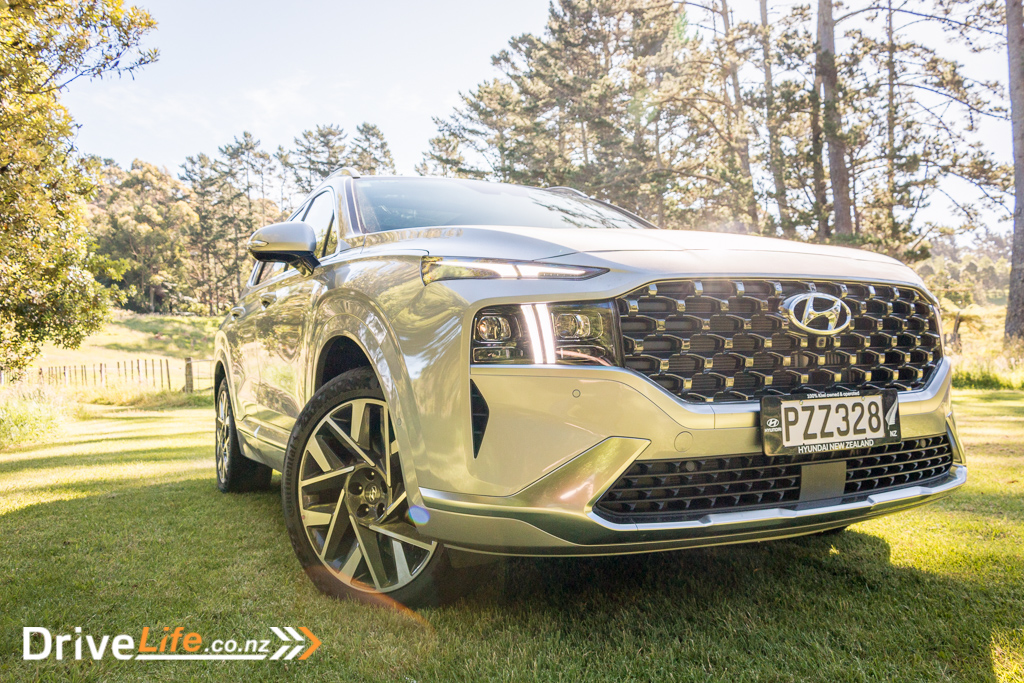
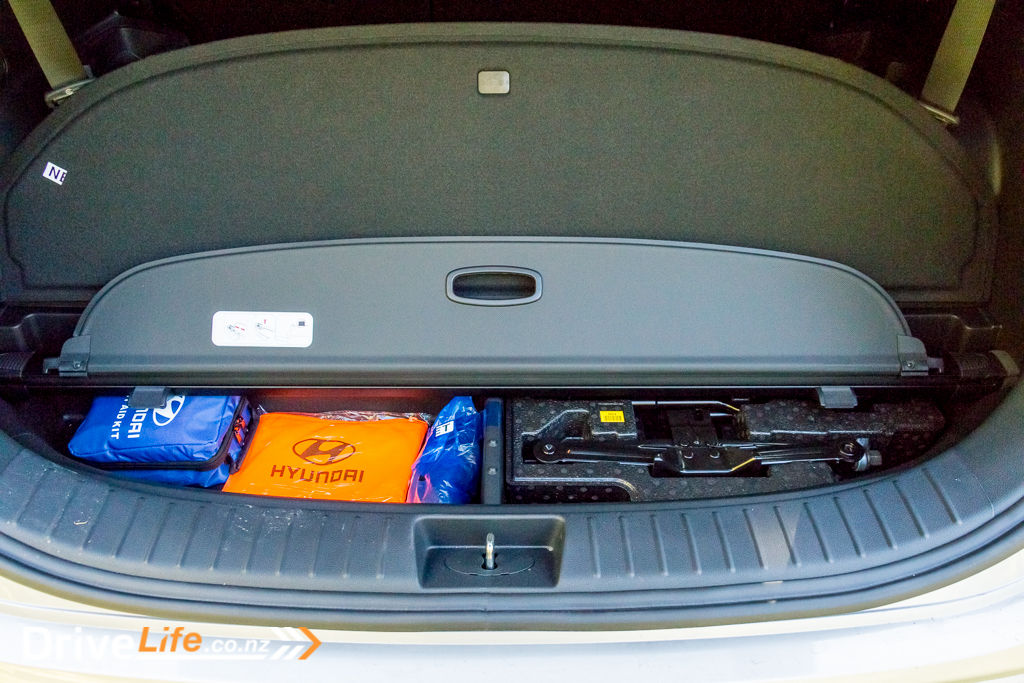
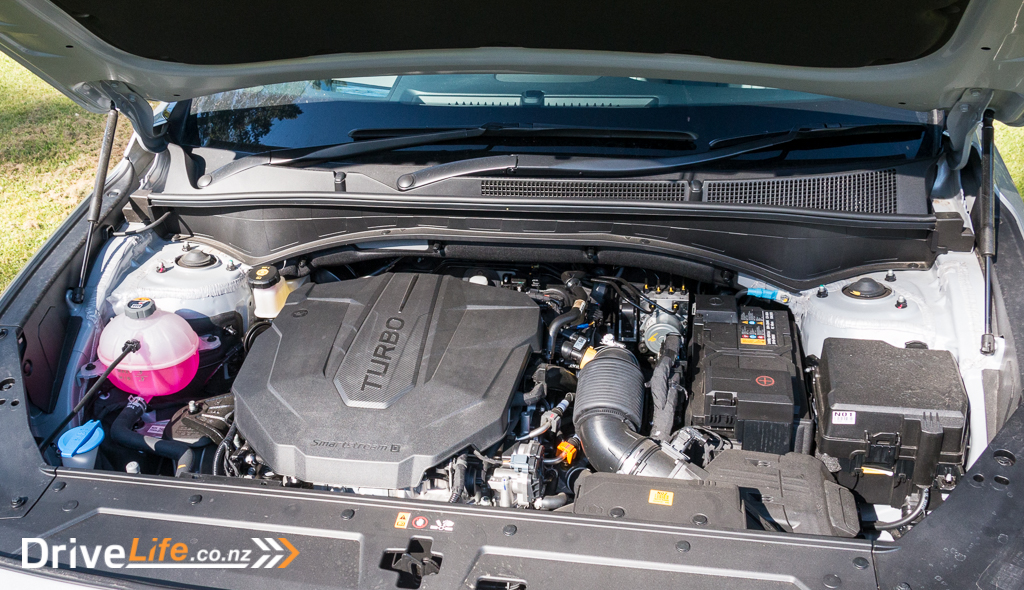
- Driver Attention Alert (DAA)
- Safe Exit Assist (SEA)
- Rear Occupant Alert (ROA)
- 7 Airbags (Dual Front, Side, Curtain and Centre Airbag)
- Front seatbelt pretensioners and load limiters
- 3-point tether child seat anchor points
- ISOFIX child seat anchor points
- Power operated child safety rear door locks
- Electro-Chromatic Rear-view Mirror (ECM)
- Automatic dusk sensing headlights
- Rain sensing wiper system
- Remote Smart Park Assist (RSPA)
- Surround View Monitor (SVM)
- Smart power tailgate
- Laminated acoustic windscreen
- Black Nappa leather interior trim
- Heated front (3-stage) & outboard 2nd row seats (2-stage)
- Ventilated front seats (3-stage)
- Dual zone climate control air-conditioning with pollen filter
- 3rd row air conditioning
For a full list of specs and options available for the Hyundai Santa Fe head on over to the Hyundai New Zealand’s website.
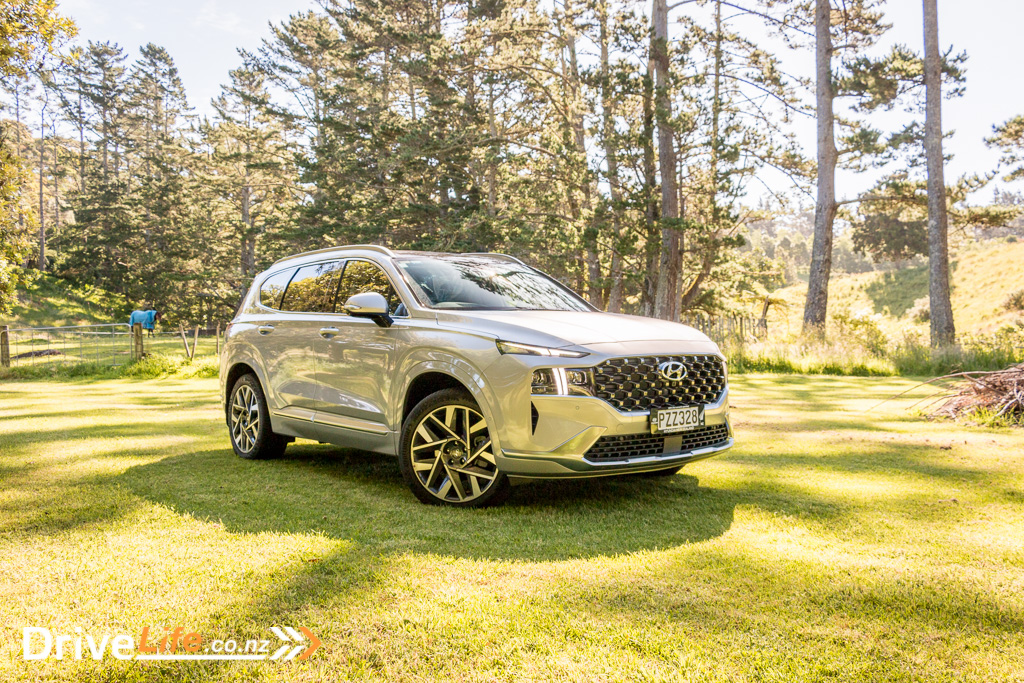
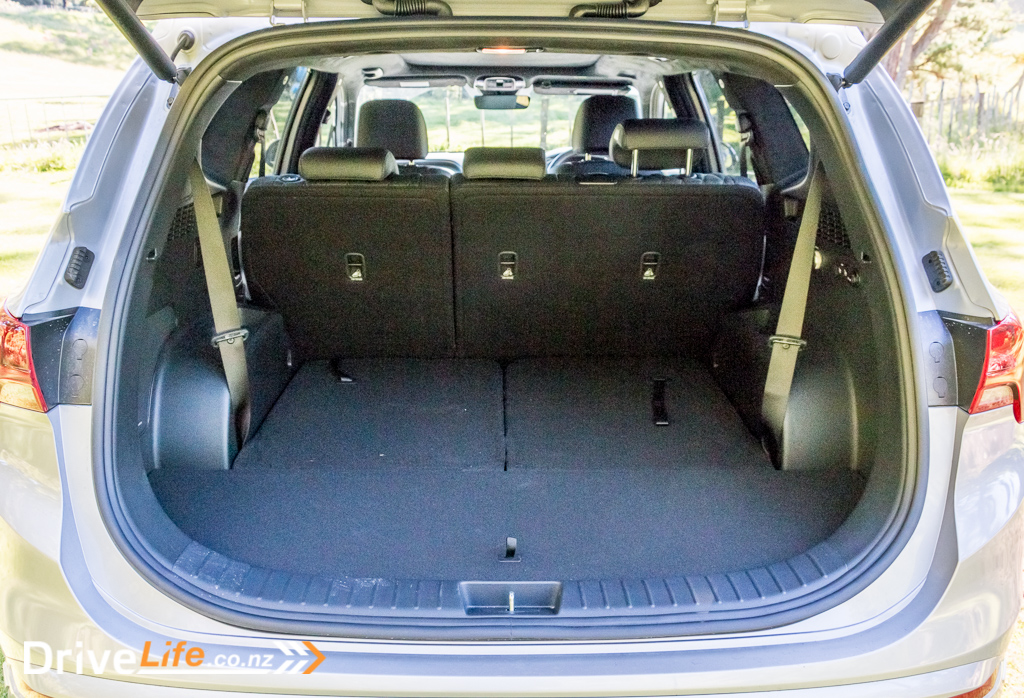
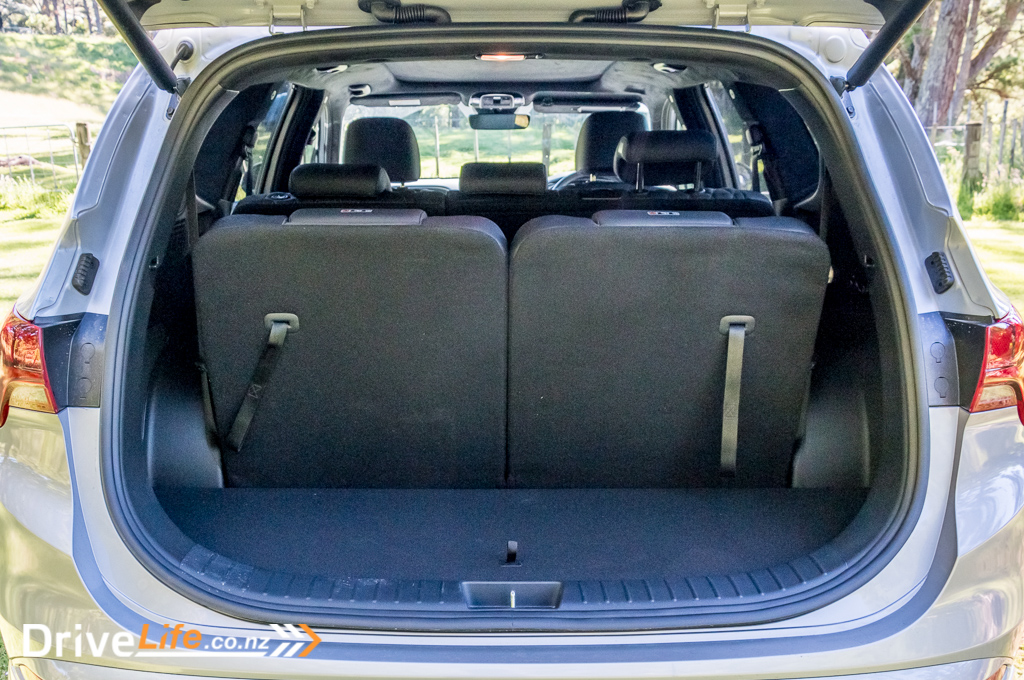
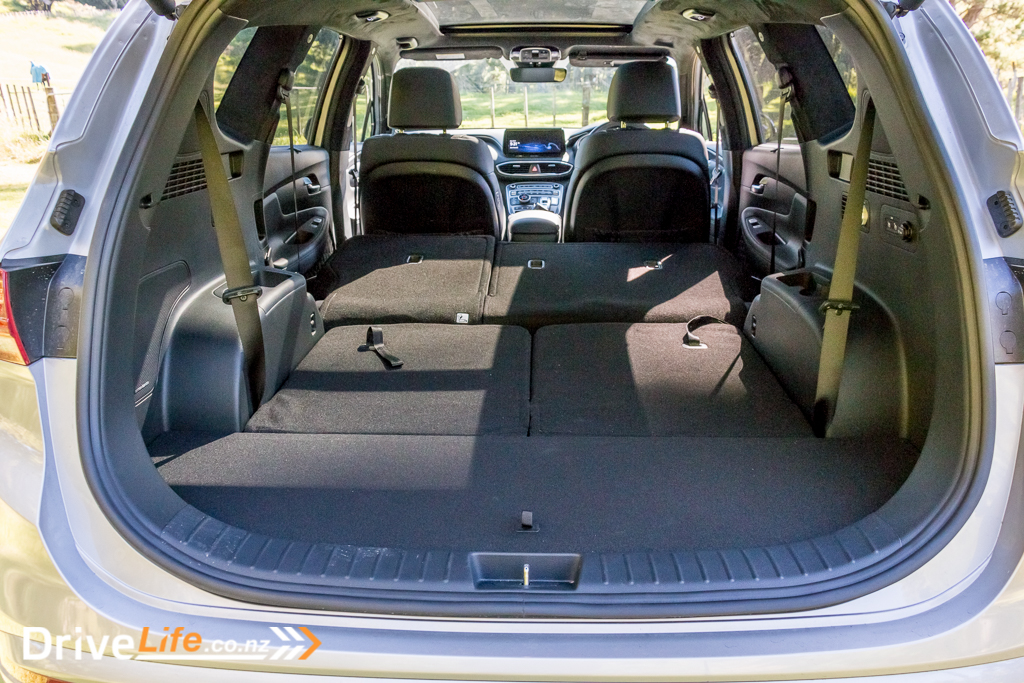
How Does The 2023 Hyundai Santa Fe Calligraphy Compare To Its Competition?
| Make/ Model | Engine | Power/ Torque kW/Nm | Seats | Fuel L/100km | Towing Capacity | Boot Space, litres | Price |
| Volvo XC90 B5 Momentum | 2.0-litre 4-cylinder petrol twin-turbo hybrid | 183/350 | 7 | 8.2 | 700/2,400 | 651 | $101,900 |
| Nissan Pathfinder Ti-L | 3.5-litre, V6 petrol | 202/340 | 7 | 11.7 | 750/2,700 | 557 | $88,490 |
| Skoda Kodiaq RS | 2.0-litre 4-cylinder petrol-turbo | 180/370 | 7 | 8.3 | NA/2,000 | 630 | $84,990 |
| Kia Sorento AWD Premium | 1.6-litre, 4-cylinder petrol-hybrid | 195/350 | 7 | 6.0 | 750/1,650 | 608 | $84,990 |
| Hyundai Santa Fe Calligraphy | 2.2-litre 4-cylinder turbodiesel | 148/440 | 7 | 7.1 | 2500 | 571 | $82,990 |
| Toyota Highlander ZR Hybrid | 2.5-litre, 4-cylinder petrol-hybrid | 142/242 | 7 | 6.2 | 700/2,000 | 552 | $78,290 |
| Mazda CX-9 Takami | 2.5-litre, 4-cylinder, petrol-turbo | 170/420 | 7 | 8.8 | 750/2,000 | 742 | $74,690 |
Please note DriveLife does its best to ensure the information below is correct at the time of publication, however, prices, specifications and models can change over time. Please bear that in mind when comparing models in the comparison table.
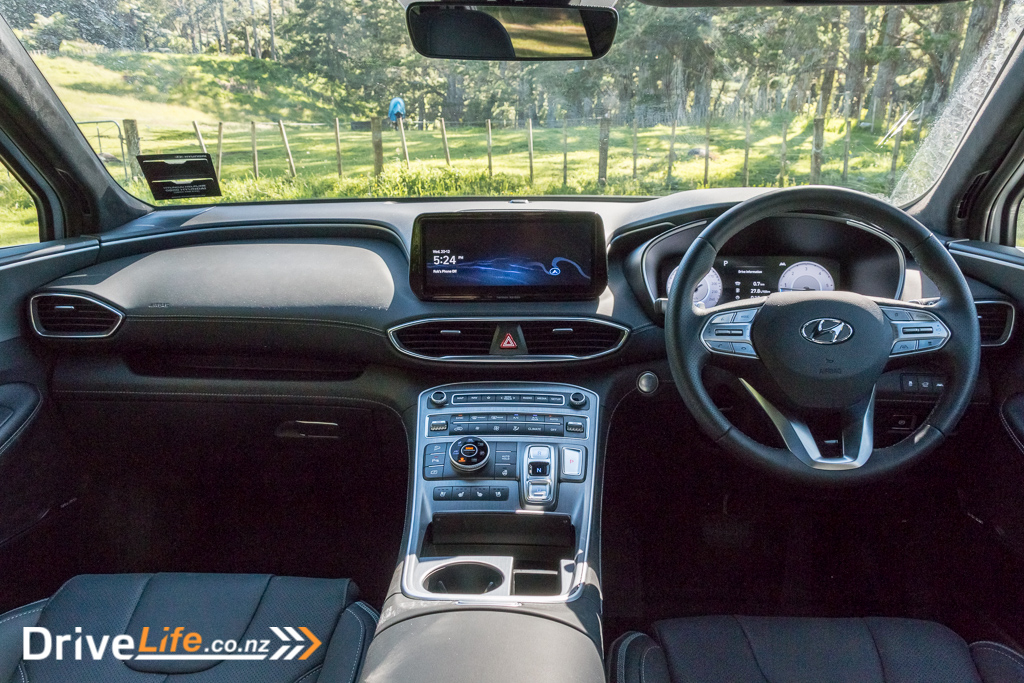
First Impressions Of The 2023 Hyundai Santa Fe Calligraphy
The Santa Fe Calligraphy takes the top-spec Limited model and adds body-coloured lower trims, a dark chrome grille, and unique Calligraphy 20” alloy wheels. All of this adds an extra touch of class to the already handsome design. There are only four colours available and all are monochrome shades, though saying that our test car looks it looks great in Typhoon Silver.
The front end has a massive grille, as is the fashion, but it’s broken up a little with the lights. I like the DRLs very much, the way they make a T-shape split between two light units. They give the front an aggressive, slightly snake-like look.
Side proportions are very good with those 20” wheels fitting in nicely with the overall design. The body-coloured lower trims make the car look lower and somehow heavier than the lower-spec models, but not in a bad way.
The rear is pretty clean-looking with a full with light strip and LED tail lights. Exhausts are hidden away beneath the bumper,
Overall it’s a handsome vehicle with a premium look.
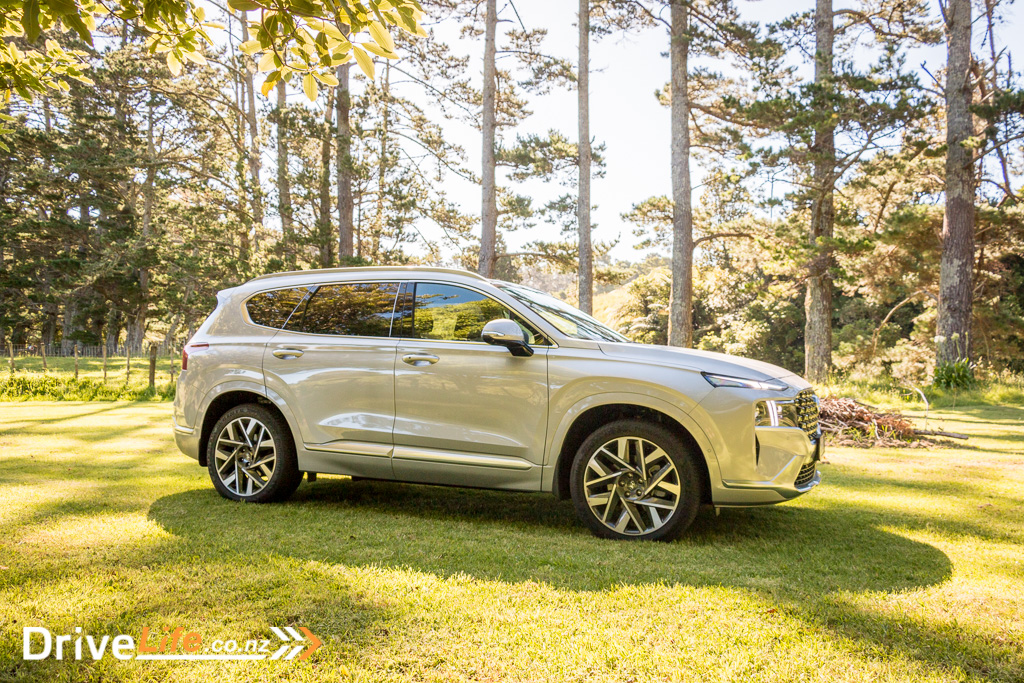
What’s The Interior Like In The 2023 Hyundai Santa Fe Calligraphy?
The interior is the other place where the Calligraphy spec lifts the Santa Fe’s game. Hyundai have upgraded to aluminium finishes on the centre console, added a heated perforated-leather steering wheel, and more significantly the seats are trimmed in full Nappa leather. It’s a similar feel to the top-spec Pallisade, and it’s rather luxurious. The quilted diamond-stitching on the shoulder portion of the seats looks excellent.
The leather and the head liner are dark grey but there’s a massive double-glass roof to lighten things up. The front half opens with a tilt and slide mechanism.
The seats are very comfortable, with 14-way electric adjustment for the driver and 8-way for the passenger. Front row seats are heated and ventilated, with the three levels of heating and cooling linked to the climate control. This feature works really well in practice with the system knowing when to heat or cool you, the measure of success for this sort of thing is that it never irritated me.
The outer middle-row seats are 2-stage heated and I had no complaints about comfort throughout our trip. The angle of the centre row seat backs can be reclined slightly which definitely helped with comfort on the longer drives.
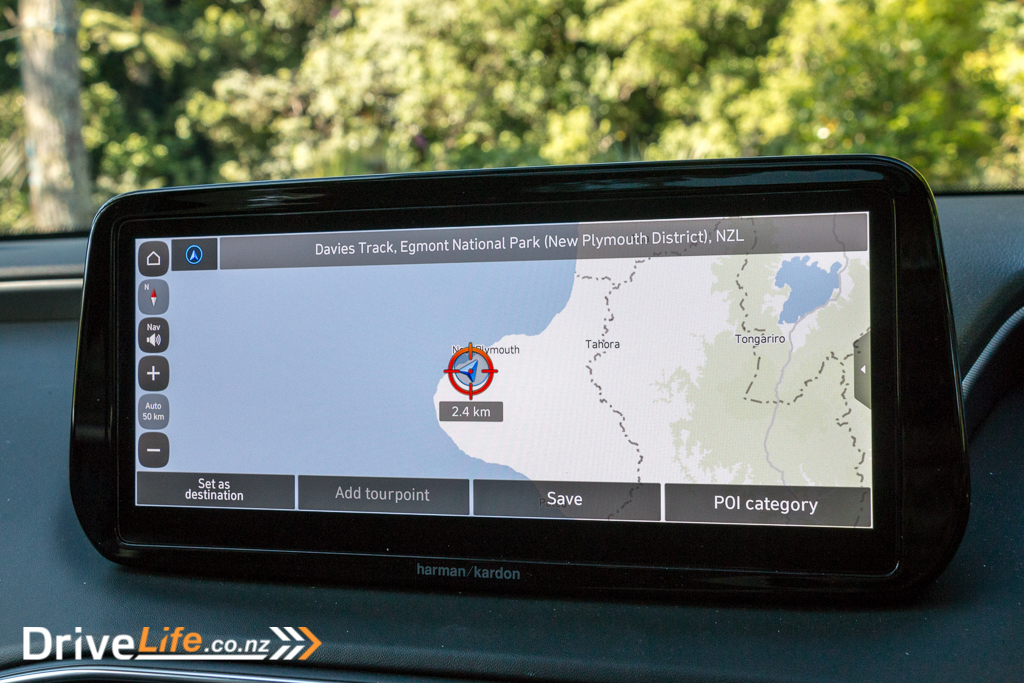
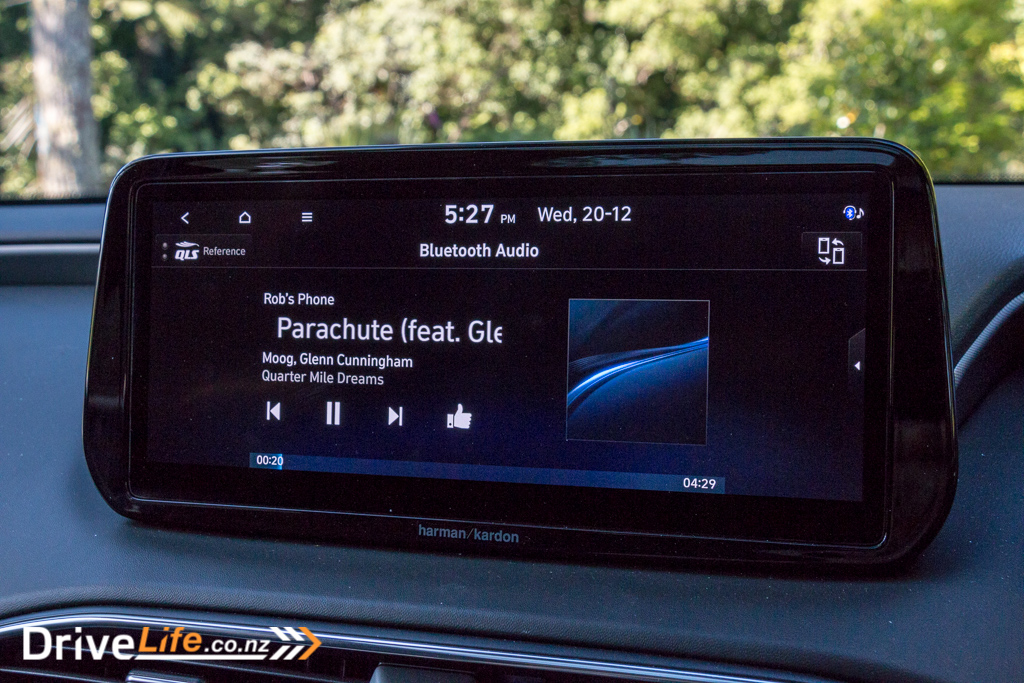
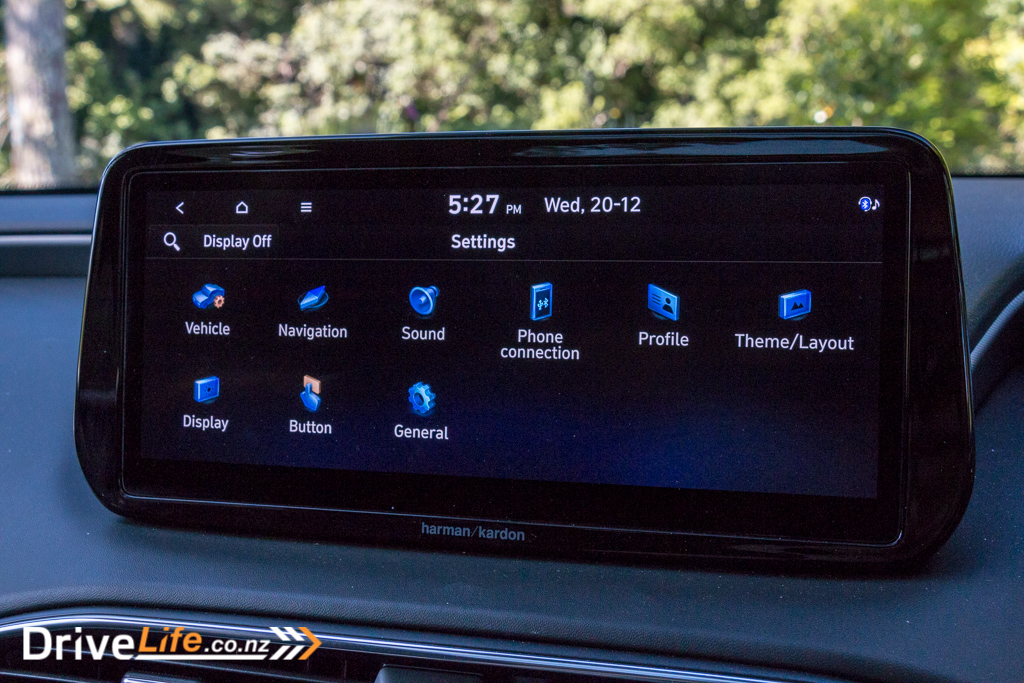
My teenager decided that the third row seat was her preferred spot for the trip, and the other third row seat was folded down to give us more cargo space. There’s only 130 litres of space behind the third row, enough for a few shopping bags. Fold down both third row seats and you have 571 to 782 litres depending on the angle and position of the middle row seats. Fold those and you have a cavernous 1,649 litres.
This is where we had some difficulty with the setup. The third row right-hand seat has climate controls and USB ports for the teenager, but the third row is designed, logically enough, to be easiest to access via the left side. I was texted the following by said teenager:
In the very back seats there is plenty of leg room but it is quite inconvenient to get in and out. On the left side it is easy with having the button that drops the seat and moves it forward. But the right side doesn’t have that button but everything like the USB port and A/C controls are on the right side not the left. I think that there should either be the controls on the left as well or just also have a button for easy exiting.
The middle seats are also heavy and have strong springs to drop them forward. This makes them easy to drop flat (top tip – don’t squash your mum when by pressing the button when she’s still in the seat) but they need quite a lot of effort to push back into place.
The front passenger seat has buttons on the side so that rear passenger can move it forward. I’m still not sure exactly what this feature is for – maybe for making space when installing a child seat in the rear? It’s definitely ripe for abuse by your kids though!
Like the Pallisade, the Santa Fe has a driver-to-third-row intercom system so you don’t have to shout at your teen to get their attention. It works well but is a bit fiddly to find in the screen menus. A dedicated on/off button for this would be really useful.
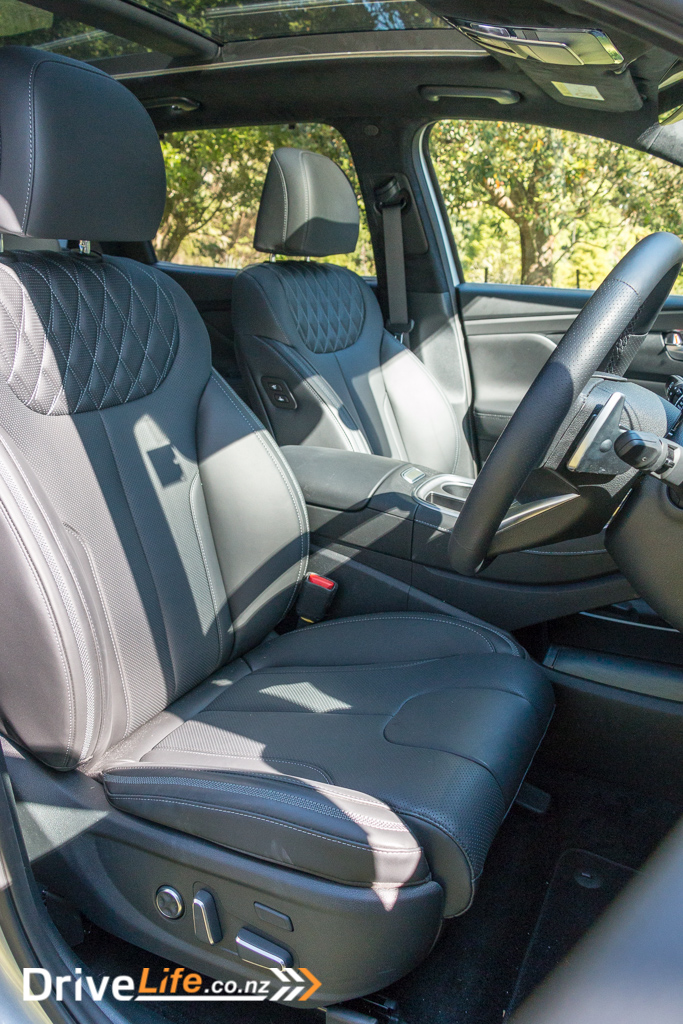
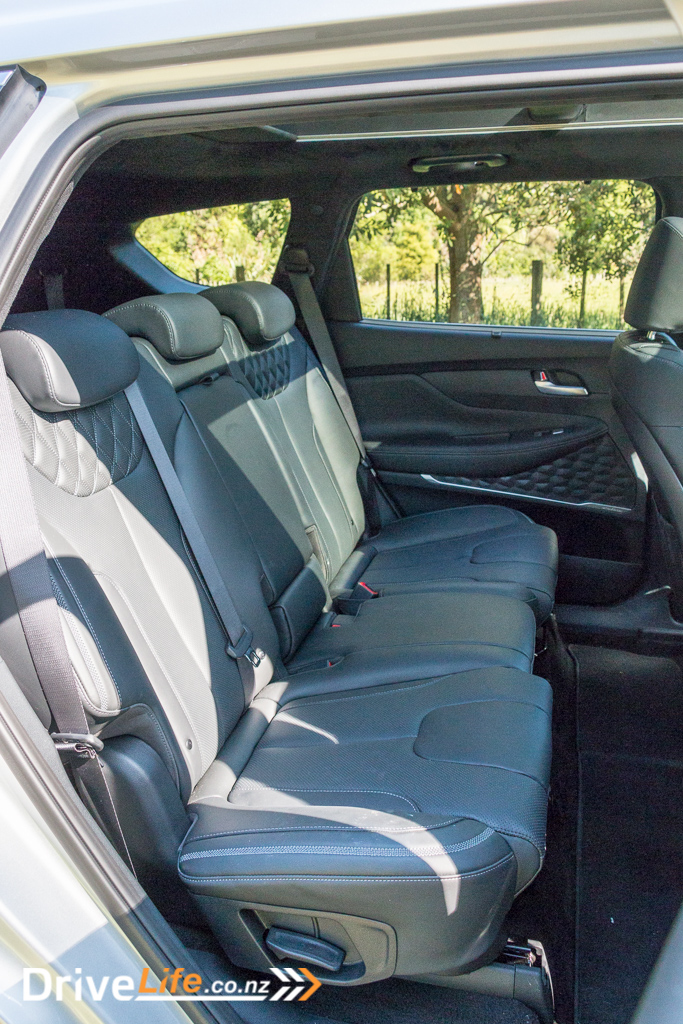
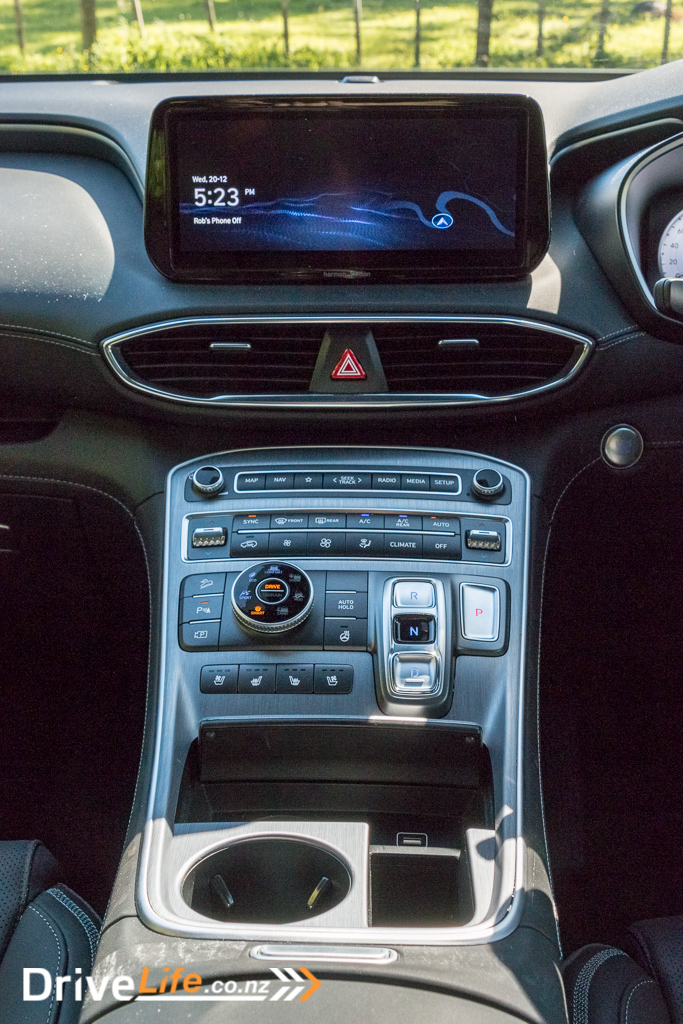
Back into the front of the Santa Fe and everything will feel very familiar to you if you’ve been in any recent Hyundai or even Kia. My wife has a Kia Sorento, and though it looks quite different both inside and out, the family resemblances are unmistakable in the look, feel and functionality of controls. This is a good thing as I think the Korean cars have an excellent balance of touch versus physical controls.
There’s a high-mounted 10.25” touch screen for the media system, satnav and vehicle setup, but there are physical buttons in the centre console to switch between media, maps etc. Below those are controls for the dual-zone front climate control, seat heating and cooling, as well as a jog wheel for drive modes, and push-buttons for the gear shifts.
Under that is a covered wireless phone charger, cup holder, and nice deep cubby which is great for phones or wallets.
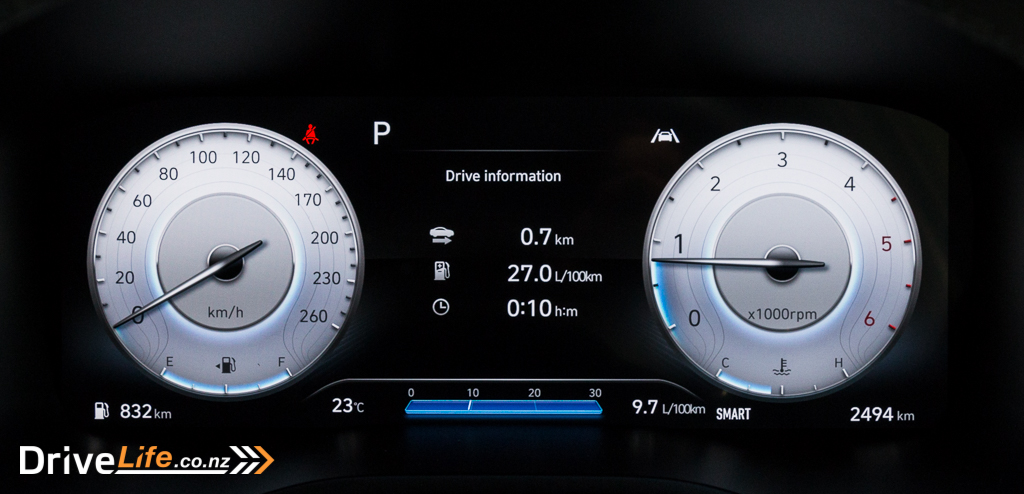
The driver display is a fully digital 12.3” screen which has excellent clarity and is easy to see in all conditions. It changes colour according to drive mode but is configured in the standard two-dial display by default, with additional information in the centre. The dials turn into a blind-spot camera view left or right when you’re indicating which is a really useful safety feature in conjunction with the blind spot monitor. We love this feature and gave it an honourable mention for best gadget in our 2021 car of the year awards.
The buttons on the wheel are easy to use for controlling the stereo and cruise control system. There’s also a button on the wheel which can be held for two seconds to turn off the Lane Assist system. This turns back on every time the car is started. It’s a good safety system on well-marked highways but on New Zealand’s more rural roads it can be more of an annoyance and an un-safety feature when the lines are poor or nonexistent.
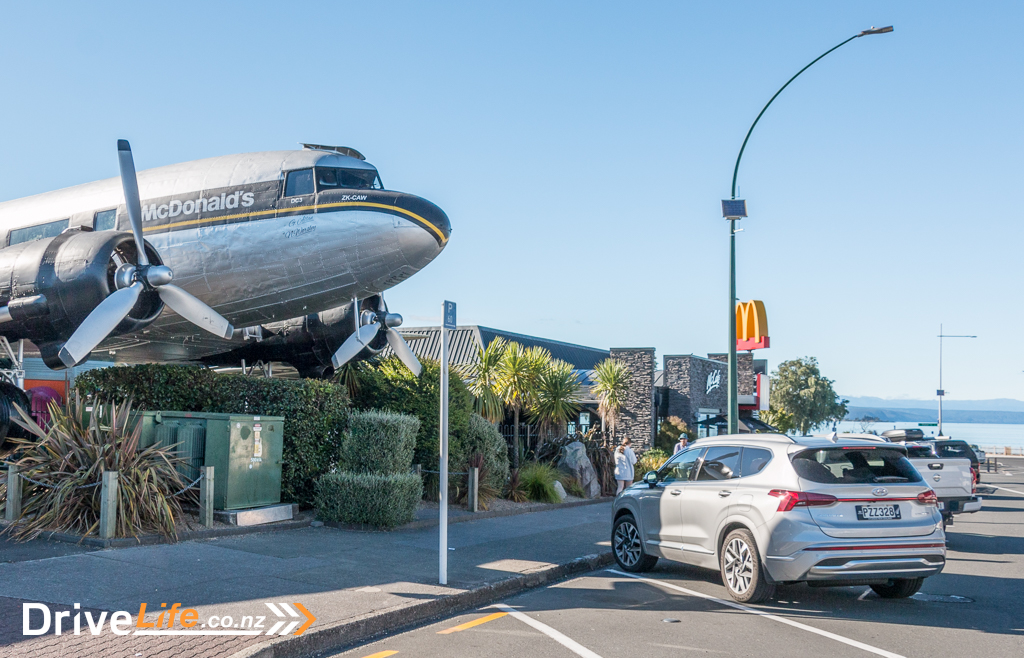
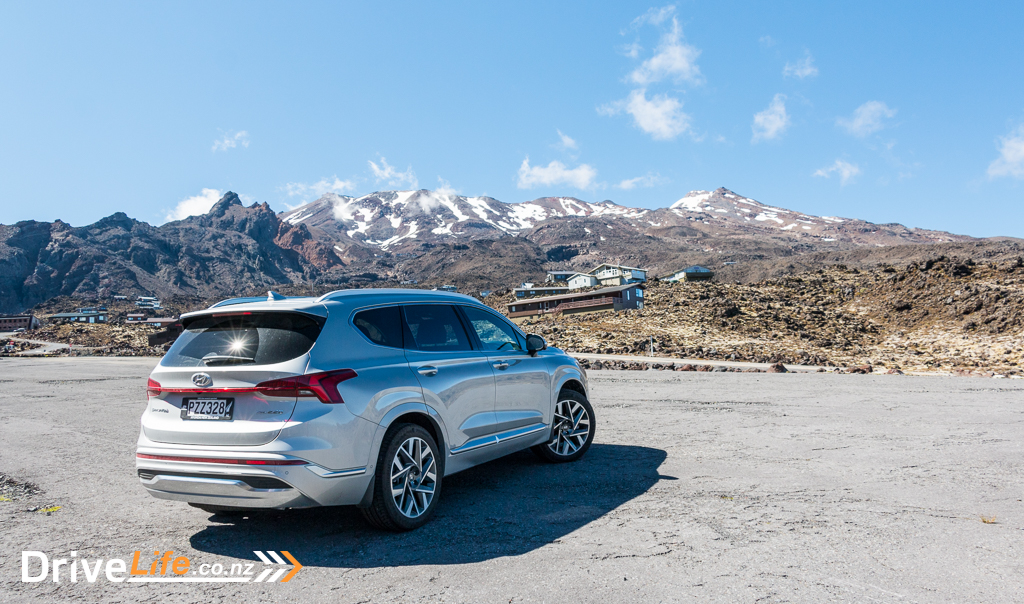
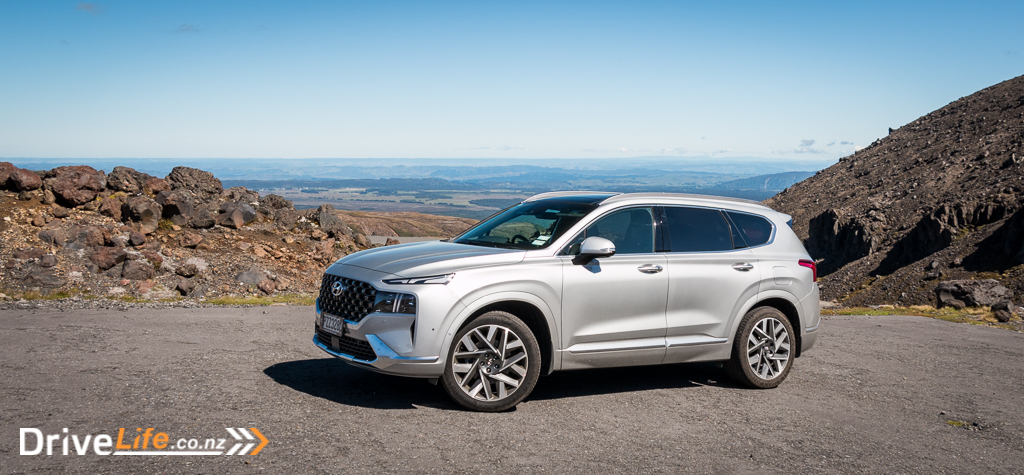
What’s The 2023 Hyundai Santa Fe Calligraphy Like To Drive?
For the first week of driving the Santa Fe it was wet and foggy in Taranaki – really weird weather for summer – but I doubt there was a better car to be tooling around in. It felt solid, composed and safe at all times, and the aircon did an excellent job of defogging windows and keeping everything dry. Around town the Santa Fe is just easy, it’s a big car but doesn’t really feel it when you’re driving. You’re up high with good visibility but there’s no worries about placing the car or parking. The top-down view on the camera system is clear, with dynamic guide lines, and I never worried about placing the Santa Fe into a space.
The Santa Fe has rear cross-traffic alert which is a fantastic safety feature, warning you of oncoming cars before you can see them. It makes a sound, vibrates the wheel and shows a red symbol on the HUD so there’s no excuse to reverse in front of anyone! Just once the system actively stopped the car, so a car nowhere near us on the opposite side of the road. It wasn’t quite as full-on as the German systems though so no-one got whiplash.
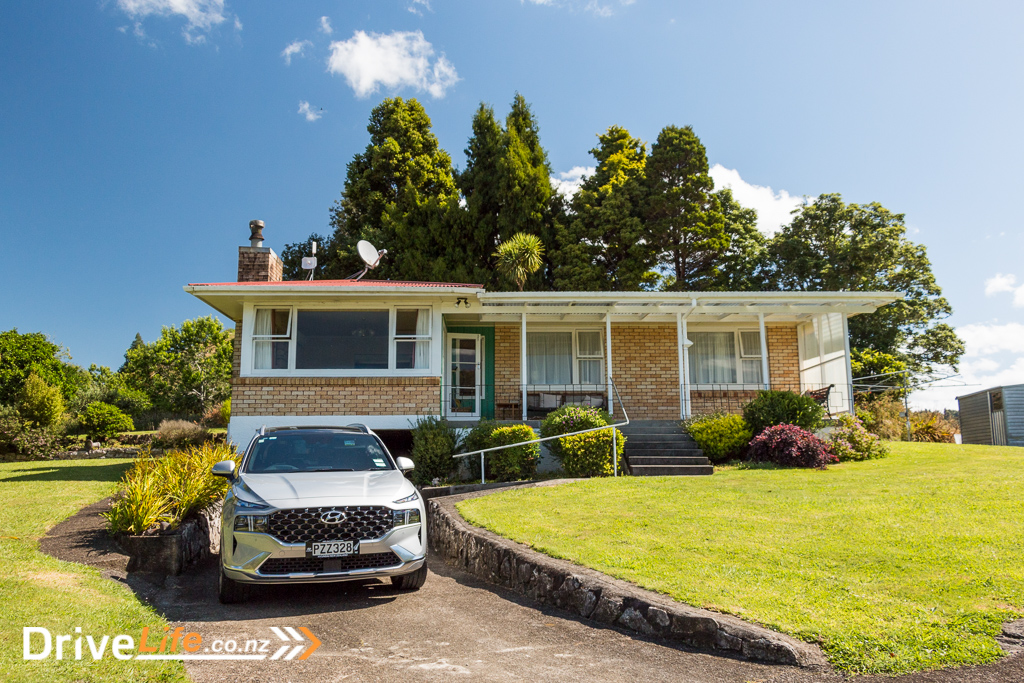
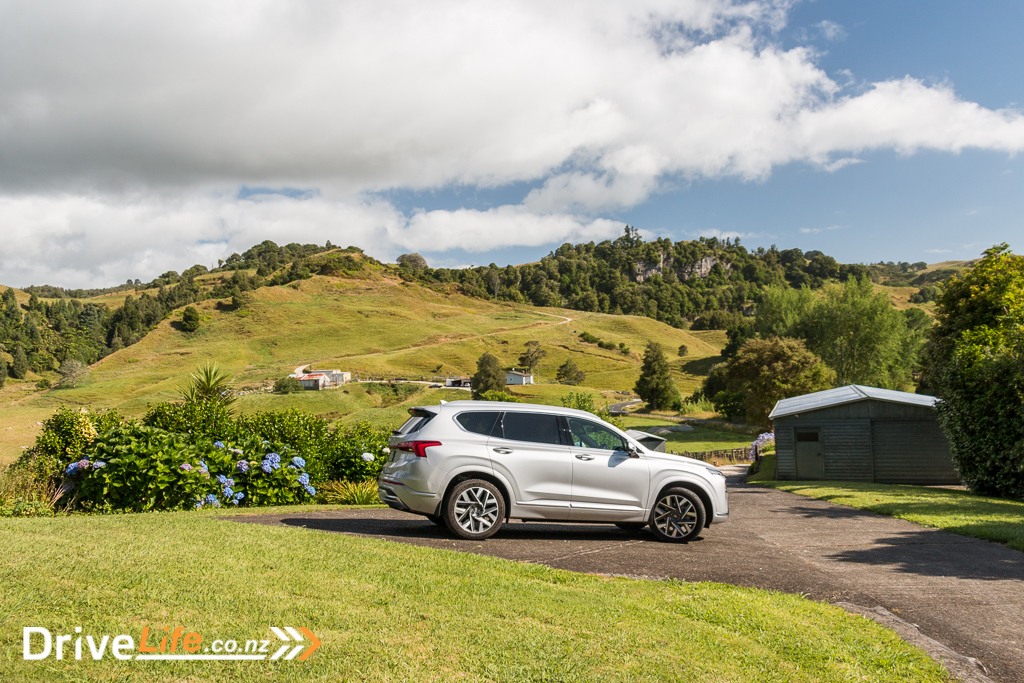
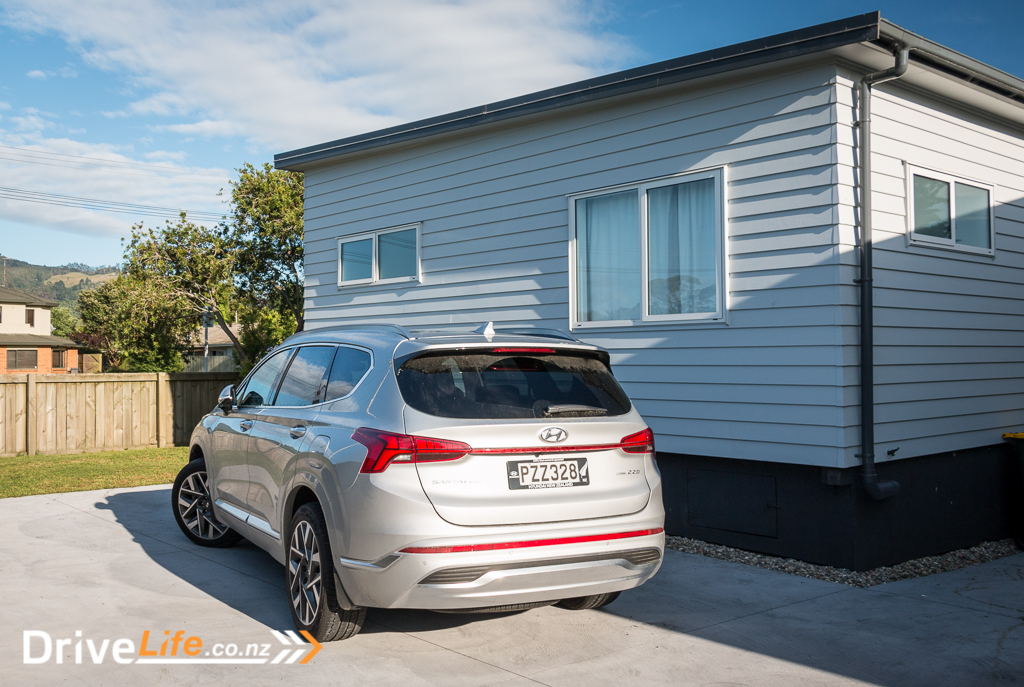
It may be a diesel, but inside, it’s smooth and quiet, with a nice, muted growl on acceleration. Most of the time you barely hear the engine, or really feel the gear shifts. The refinement of the drivetrain very is impressive. The only thing that’s annoying around town is the navigation’s default setting where every time you are about to pass a school, your music goes quiet and an Australian-sounding lady says “School zone ahead”. This can be turned off in the map settings, and only activates at around school hours, but when your morning commute passes six schools, and it says it once or twice per school, it gets old pretty quickly.
So, to the road trip. On the day we were due to set off the clouds lifted and we suddenly had the Kiwi summer we had been waiting for! We packed up the car, dropping one of the rear seats flat so that we had enough space for five plus luggage. Everyone was comfortable with plenty of room. We kept the full-length roof blind shut for the whole trip, just to insulate us a bit more from the blazing sun.
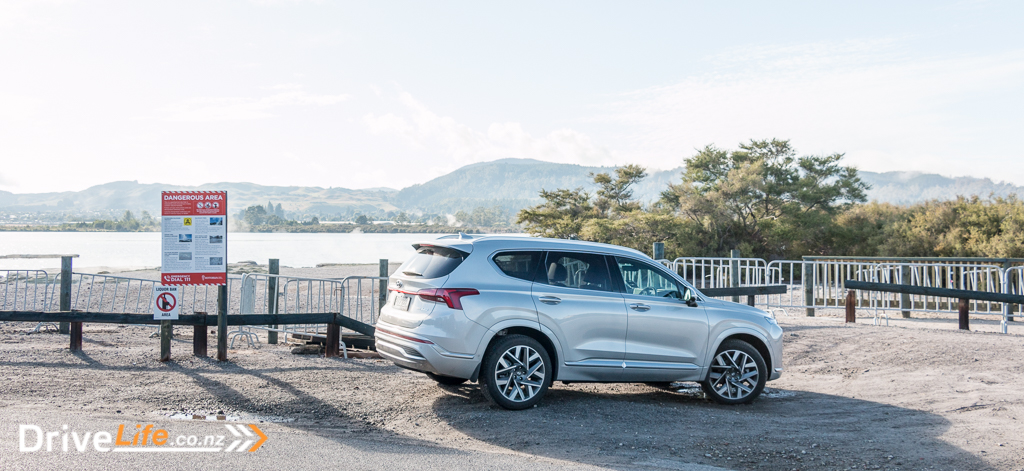
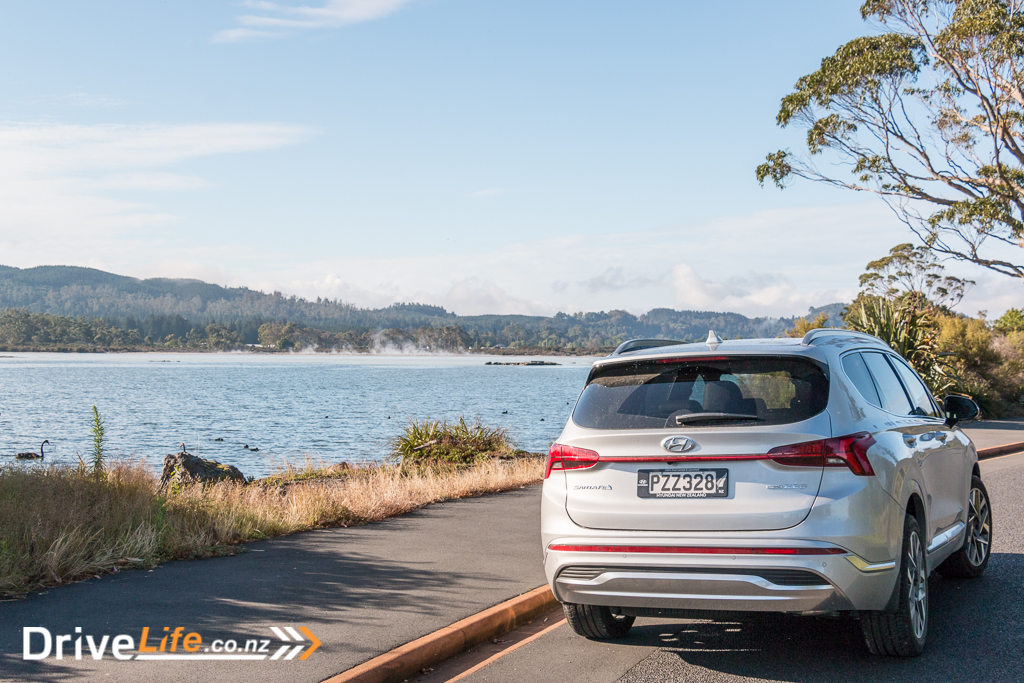
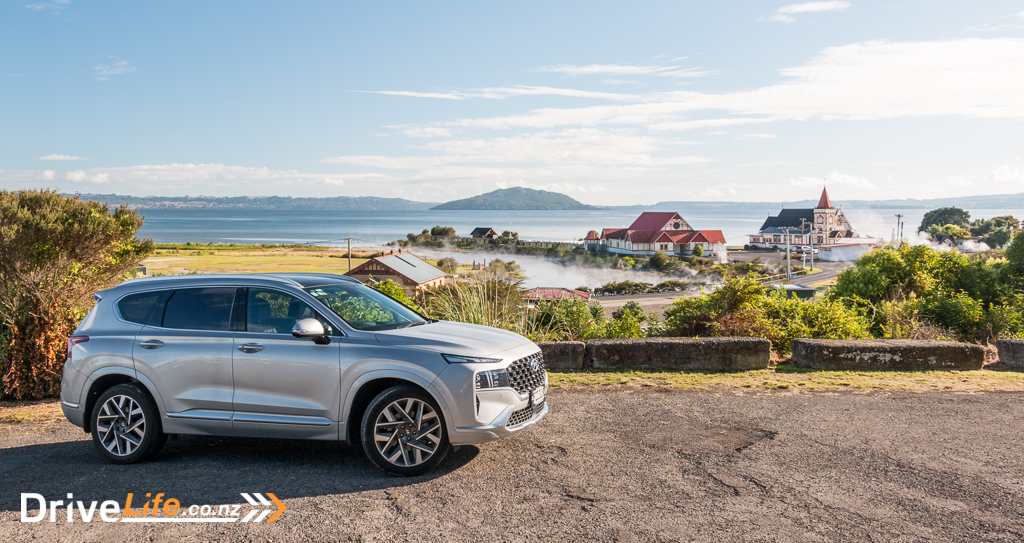
Our trip went from New Plymouth to Waitomo Caves, to Rotorua, to Taupo and back to New Plymouth, covering some of the North island’s favourite tourist spots but keeping the driving time on most days to less than three hours at a time. I made lots of use of the radar cruise control, and it worked really well on the highways. I almost always turned off the lane assist because it beeps too much on rural roads. The cruise worked well to make the journey less tiring for me, and to make it easier to keep within speed limits.
The Santa Fe is a big car, but with 440Nm of torque, acceleration off the line is surprisingly sprightly, and overtaking is a breeze. It didn’t feel any different with just me on board or all five plus luggage. Handling is generally pretty neutral, with a bit of body roll on the corners, but not enough to cause carsickness in the back. Quite a few cars like this can feel numb to drive, or wallowly, or very much show their weight. The Santa Fe does none of these things. It’s not exactly what I’d call engaging to drive but it’s also not annoying in any way, and can be satisfying to drive smoothly. This is quite the accolade I think, for a nearly-two-ton SUV.
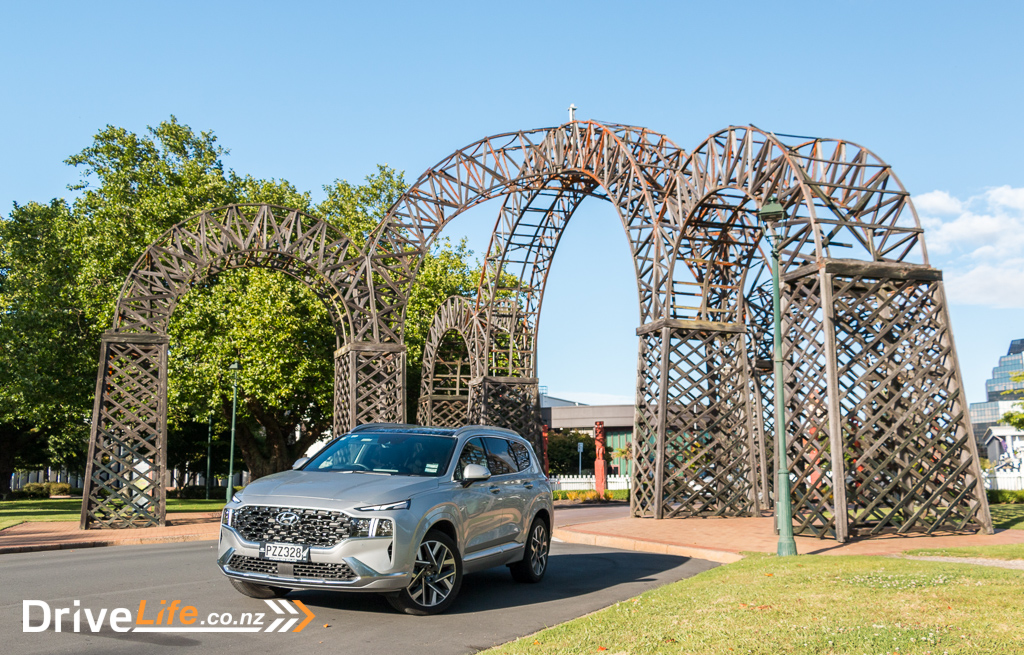
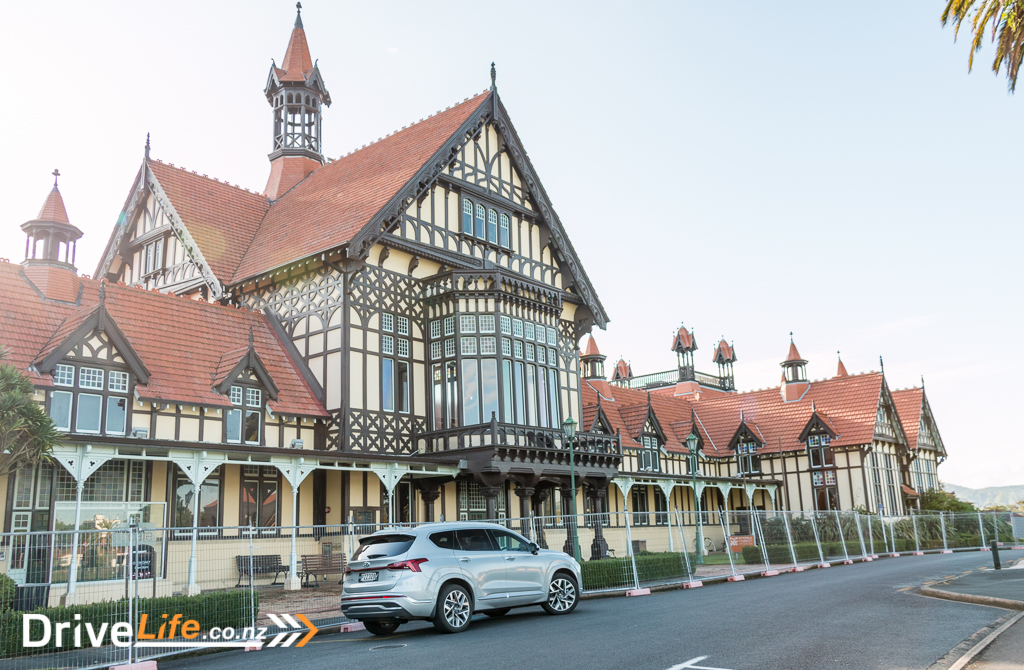
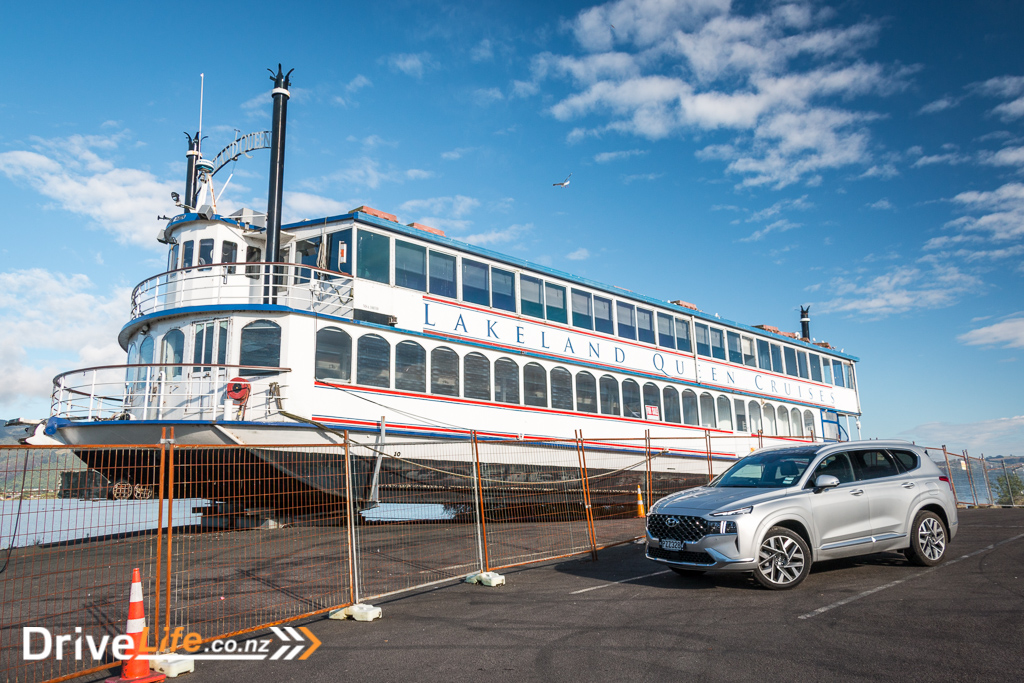
The Continental tyres fitted to those 20” Calligraphy wheels are surprisingly quiet, with some tyre roar on the roughest of chip seal, but far less than many other similar cars I’ve driven. Even on gravel roads it wasn’t particularly noisy, and was comfortable at all times.
The more I drove the Santa Fe, the more I came to like it, and I concluded that for our road trip it was the perfect vehicle. There’s nothing about it that I didn’t like, and there were very few issues. Sometimes it saw the coats on the centre middle seat as a person and sounded the seatbelt warning for a couple of minutes. Occasionally there was a slight buzzy rattle in the driver’s door or the A-pillar. I’m clutching at straws here because it’s such a great family car.
Even the fuel consumption was excellent; Hyundai quotes fuel usage of 7.1 litres per 100km combined, and over 2,000km we averaged 7.3l/100km. That’s an impressive result for a large car driving fully loaded most of the time with aircon blasting.
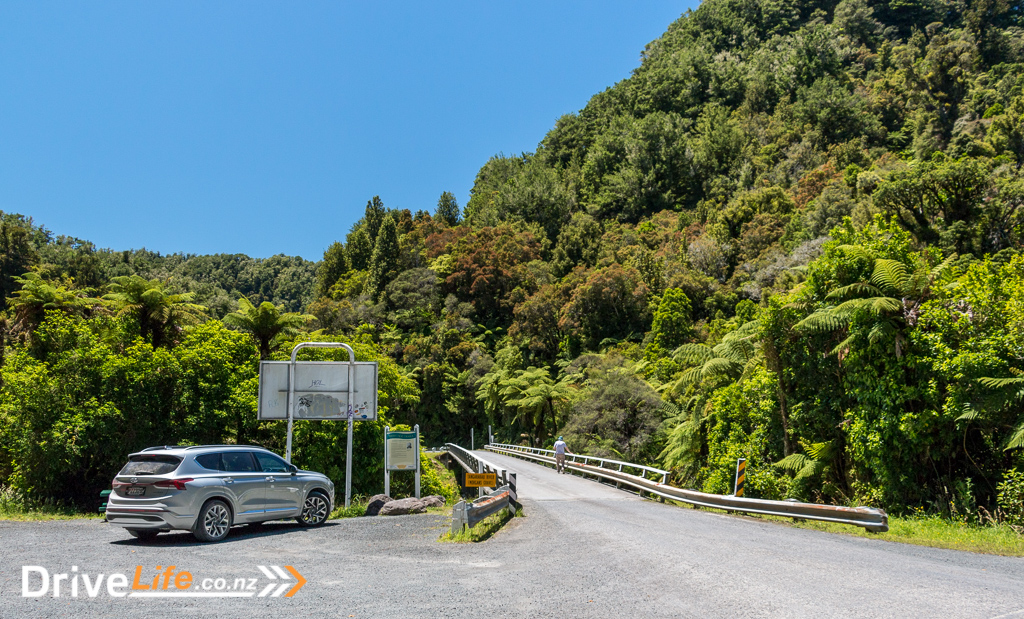
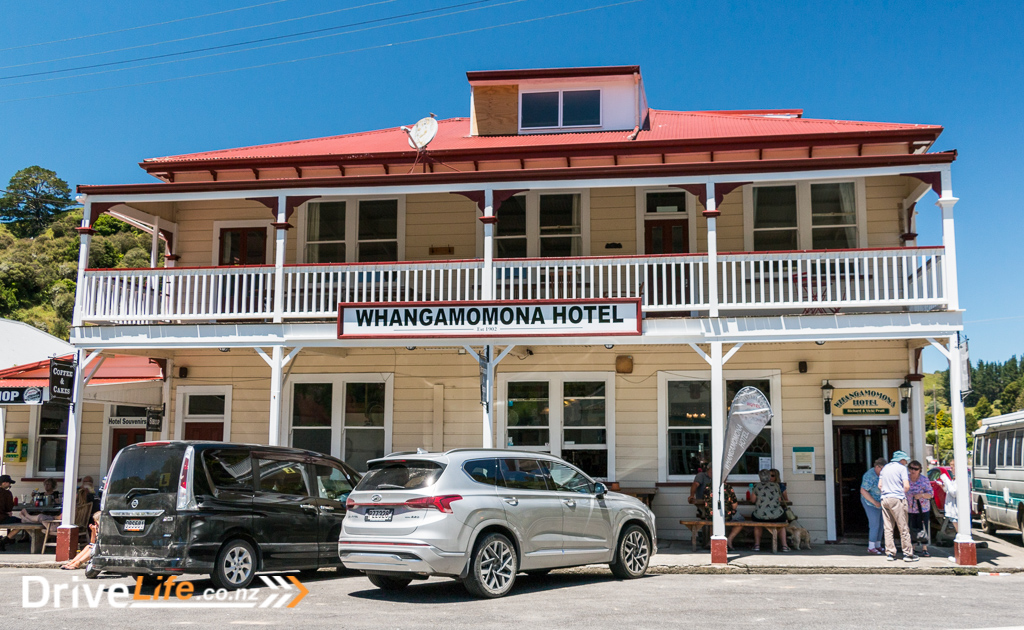
2023 Hyundai Santa Fe Calligraphy – Specifications
| Vehicle Type | SUV |
| Starting Price | Recommended Retail Price (RRP) $94,990 Recommended Special Price after discount (RSP) $82,990 |
| Price as Tested | $82,990 |
| Engine | 2.2 litre 16 valve twin overhead cam with common rail direct injection and variable geometry turbocharger |
| Power, Torque kW/Nm | 148/440 |
| Transmission | 8 Speed Dual Clutch Transmission (Wet Clutch Type) |
| Spare Wheel | Full-sized spare |
| Kerb Weight, Kg | 1,820 – 1,943 |
| Length x Width x Height mm | 4785 x 1900 x 1710 |
| Boot Space / Cargo Capacity, Litres (all seats up/rear seats down/centre and rear seats down) | 130/571-782/1649 |
| Fuel tank capacity, litres | 67 |
| Fuel Economy, L/100km | Advertised Spec – Combined – 7.1 Real-World Test – Combined – 7.3 Low Usage: 0-6 / Medium Usage 6-12 / High Usage 12+ |
| Towing Capacity Kg, unbraked/braked | 750/2,500 |
| Turning circle metres | 11.4 Small: 6-10m / Medium 10-12m / Large 12m+ |
| Warranty | 10 year / 200,000 km anti perforation corrosion body warranty 3 year / 100,000 km mechanical warranty 3 year / 100,000 km roadside assistance package |
| Safety information | ANCAP Rating – 5 stars – Link Rightcar.govt.nz – 5 Stars – PZZ328 |


